|
Outside
in the Sunshine
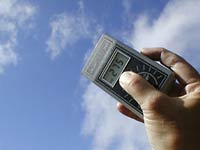 Two
types of recording are possible outdoors. Two
types of recording are possible outdoors.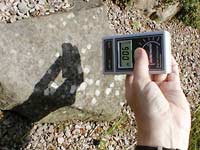
Direct readings are those where
the meter is aimed directly at the sun (Figure 1). These indicate
the maximum amount of UVB which a basking reptile would receive
on its skin if it was sitting in full sunlight, angling its
body toward the sun.
Indirect readings are those where
the meter is aimed in other directions. These are more indicative
of the amount of UVB a reptile receives
on its skin
from reflected UVB. On a sunny day, UVB reflected and diffused
from the sky and from the ground can reach quite high
levels even in full shade. Figures 2 and 3 show readings of
reflected UVB from a stone slab, and diffused UVB recorded
in shade, taken within minutes of the direct solar reading
shown in Figure 1.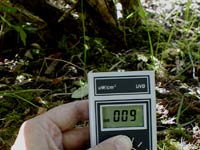
To give us some idea of the sort of UVB levels found in nature,
we are working with other members of the international internet
group
UVB_Meter_Owners to build a database of solar UVB recordings
taken throughout the world at different times of day and months
of the year.
Because there are considerable technical difficulties involved
in the measurement of ultraviolet light, and different UVB
radiometers of equivalent accuracy are known to give different
readings with the same light source (18)
all the recordings are collected using the same instrument,
the Solarmeter Model 6.2 UVB.
This work is far from complete. Full details and updates are
available from the group website, and we welcome new contributions.
When considering
UVB in nature it is very important to remember that NO reptiles
sit out in the sun all day. It is easiest to record maximum
levels of solar UVB out in the open, under a clear sky. It
is valid to gather such data since this gives a clear indication
of the maximum UVB that a basking reptile could receive.
It is far from valid, even dangerous, then to suggest that
these levels should be provided in the vivarium. Account must
be taken of the microhabitat, for every species. What shade
and shelter does a wild reptile have? Does it ever see full
sunlight? We are hoping to collect data from reptile microhabitats
as well as
readings
taken under an open sky on clear days... but
both types of recording are necessary.
Figure
4 (below) shows one set of "clear open skies" data
from this group: solar UVB recordings from right across the
world, made over the December solstice 2005.
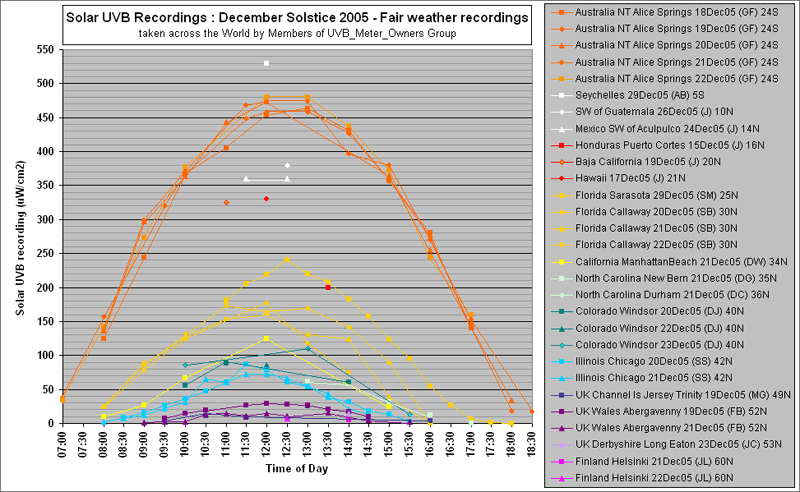
The most important factor is the angle of the sun. When the
sun is low on the horizon, its light must pass through a thicker
layer of the atmosphere, which absorbs more UV light. Highest
readings are therefore obtained around mid-day when the sun
is highest in the sky or at high altitudes where the air is
thinner. The highest readings of all (at sea level) will
be seen under clear skies in the Tropics when the sun is directly
overhead. At the equinoxes, this will be at the Equator; at
the solstices, it will be along the Tropic of Cancer in June
and the Tropic of Capricorn in December.
The further from the equator, the lower the UVB reading even
at mid-day, because the sun will be lower in the sky. The
lowest readings of all will be seen at high latitudes in either
hemisphere during winter months - when the days are short
and the sun does not rise high in the sky.
This effect
is easily seen by examining the above chart. At the December
solstice the sun is almost directly overhead at Alice Springs,
in the Northern Territories, Australia. On clear days the
UVB rises to above 100 microwatts
per square centimetre (µW/cm²) by 8.00am and reaches
over 450µW/cm² by noon. Levels above 20µW/cm² are seen for
11 hours or more.
The further
north that recordings are made, the lower the maximum (noon)
reading and of course, the shorter the day. In Florida, for
example, at latitudes 25 - 30N, observers recorded maximum
readings around 150 - 250 µW/cm² whereas further north in
Colorado, 40N, readings only just topped 100µW/cm².
Readings here were boosted, too, by the high altitude; not
much further north, in Illinois
at 42N, only 70 - 90µW/cm²
was seen.
Around 50N, the days are very short at this time of the year
and UVB levels are very low indeed. The
maximum reading taken in Wales (latitude 52N), despite clear
sunlight, was only 29µW/cm²;
and at Helsinki at 60N, our observer climbed onto his roof
to see the sun and recorded only 7µW/cm².
Readings
taken over several days, from the same location, can be used
to gain a clearer picture of the UVB available throughout
the course of a day. Figures 5 and 6 show recordings taken
in Wales over four days in March and early April 2005, and
seven days in June 2005, respectively.
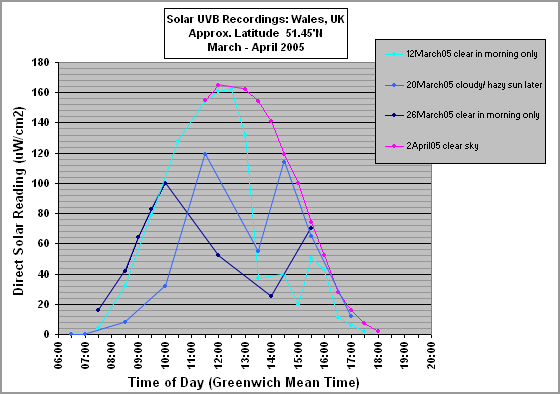

These
graphs illustrate clearly the profound effect that the amount
of cloud cover has upon the ambient UVB levels; however, by
combining readings taken on different days, it is possible
to build a picture of the maximum possible UVB as seen under
clear skies, for any given time of day during that period.
Comparison of the two charts also demonstrates the great increase
in ultraviolet light as the days lengthen and the sun rises
higher in the sky. The highest readings in June, at the time
of the summer solstice, approach 400µW/cm²
whereas in March, around the spring equinox, maximum readings
are around 160µW/cm².
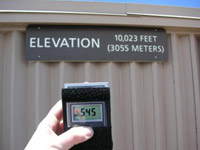
One of the highest readings yet recorded on earth with a Solarmeter
6.2 was made by UVB_Meter_Owners member Torey Lehman on the
summit of Haleakala, Mauii, Hawaii, latitude 21N, at 12.30pm
on 25th May 2005. (Fig. 7) The sun was almost overhead and
the high altitude (10,023ft) and clear sky resulted in a mid-day
UVB level of 545µW/cm².
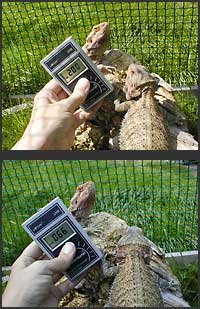
Clouds greatly affect the amount of UVB reaching the earth.
Recordings show that even near the equator, heavy cloud and
rain can reduce mid-day readings to below 100 µW/cm².
Figure 8 shows how in the UK, one small cloud reduced, in
seconds, the UVB reaching two basking bearded dragons on a
sunny day in August from 200µW/cm²
to 66µW/cm².
UVB readings on overcast days in winter in the UK may be close
to zero.
Outdoor UVB levels are affected by many other factors. A reptile
basking in sunshine receives most of his UVB directly on his
sunlit back from the solar rays, but all parts of his body
receive some UVB, just as they receive light. Both ultraviolet
and visible light are diffused and reflected by the sky, trees,
grass; everything around him. 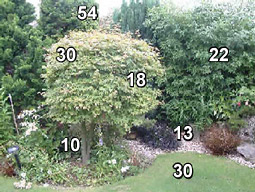
To investigate this further, a series of readings were taken
in a garden in the UK on an overcast summer day (no direct
sunlight) to examine the reflection and absorption of diffused
UVB from the sky. The results are shown in Figure 9. UVB levels
varied considerably. On the lawn and surrounding planted areas,
levels ranged from 54µW/cm²
(highest) to 13µW/cm²
(lowest). Interestingly a small area to the side of the house
surrounded by light concrete walls with a light stone patio
area produced UVB levels of in excess of 130µW/cm²,
demonstrating how reflection can cause UVB "hotspots" in nature.
Live plants absorb large amounts of UVB producing shade, but
even on an overcast day as far north as the UK, dense vegetation
did not reduce our outdoor readings to zero; even reptiles
living in shade will be exposed to low levels of ultraviolet
light.
|


















 Two
types of recording are possible outdoors.
Two
types of recording are possible outdoors.







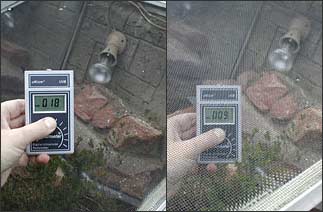
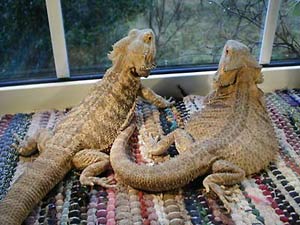 almost completely blocks
UVB. A meter aimed directly at the sun through one double-glazed glass window recorded
2uW/cm² when the unobstructed reading was 147uW/cm² - over 98.5%
was blocked. Through other windows and several glass vivarium panels, a
100% block was seen. Reptiles living indoors behind glass are unlikely, therefore, to benefit from natural UVB from the sun.
almost completely blocks
UVB. A meter aimed directly at the sun through one double-glazed glass window recorded
2uW/cm² when the unobstructed reading was 147uW/cm² - over 98.5%
was blocked. Through other windows and several glass vivarium panels, a
100% block was seen. Reptiles living indoors behind glass are unlikely, therefore, to benefit from natural UVB from the sun.